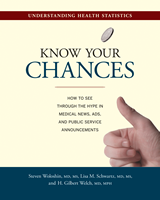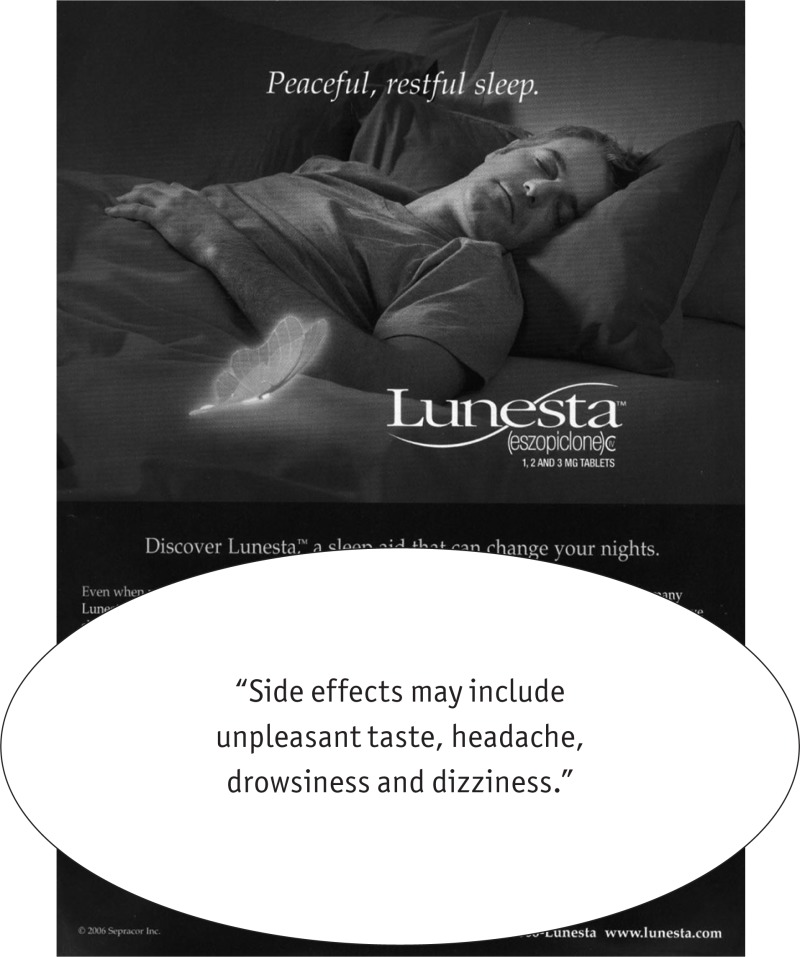Know Your Chances: Understanding Health Statistics is hereby licensed under a Creative Commons Attribution-NonCommercial-NoDerivs 3.0 Unported license, which permits copying, distribution, and transmission of the work, provided the original work is properly cited, not used for commercial purposes, nor is altered or transformed.
NCBI Bookshelf. A service of the National Library of Medicine, National Institutes of Health.
Woloshin S, Schwartz LM, Welch HG. Know Your Chances: Understanding Health Statistics. Berkeley (CA): University of California Press; 2008.
We have saved fivepence.
But at what cost?
Samuel Beckett, All That Fall
So far we have focused on benefit. That many treatments have benefits is the good news. You can probably guess the bad news: there are also downsides.
These downsides include side effects, cost, and inconvenience. We’re not going to say much about cost and inconvenience. Cost, of course, varies widely—it depends on the type of treatment, whether you have insurance, and what kind of policy you have. You have to learn what the cost is to you and decide how much it matters.
Inconvenience includes a whole range of potential nuisances. Medical care can be time-consuming and annoying—you need to make phone calls (and wait while you’re on hold), make appointments, go back for blood tests, fill out forms, get prescription refills, and so on. Again, you have to determine what the inconveniences will be and decide how much they matter.
In this chapter, we focus on side effects, the most important downsides you might experience.
All drugs and medical interventions have side effects. Although the benefit can be substantial, the side effects can be substantial too. And they may be so substantial that they overwhelm the benefit. We find it useful to think about two categories: symptom side effects and life-threatening side effects.
You should think about side effects the same way you’ve learned to think about benefit: be clear about the nature of the possible side effects of the intervention; and then, if any of them matter to you, get the numbers. This chapter lets you practice by using a few real drugs as examples. (We remind you again that we have no ties to any pharmaceutical company. Most important, we are not suggesting that you either use or avoid any of the drugs discussed.)
Let’s begin with symptom side effects, those effects that are unpleasant or even painful but not life-threatening. Many, if not most, Americans have seen the luna moth that is the symbol of the sleeping pill Lunesta. Sepracor, the drug’s manufacturer, spent over $250 million advertising the drug in 1 year. Here’s one of the magazine ads:
The U.S. Food and Drug Administration (FDA) requires that direct-to-consumer drug advertisements include a description of frequently occurring side effects. We’ve highlighted how this was done in the Lunesta ad. As you can see, four side effects are noted: unpleasant taste, headache, drowsiness, and dizziness.
If you care about any of these side effects, your next step is to get the numbers—to find out how often people taking the drug experience the side effects. Unfortunately, getting the numbers is not an easy task. This ad doesn’t provide any of the statistics (in fact, they are not available even in the “patient information” that appears in small print on the page following the ad). All you get is a list of possible side effects. Without the numbers, how can you possibly decide whether to take the drug?
Consider one of the side effects listed for Lunesta, drowsiness. Here, drowsiness means feeling sleepy the next day (when you want to be awake and alert). Would you be happy if the pill helped you sleep better at night but made you feel drowsy the next day? What chance of next-day drowsiness would be acceptable to you? If everyone who took the pill felt drowsy the next day, you probably wouldn’t want to take it. But if only 1 person in a million who took the drug felt drowsy the next day, most of us would be willing to take the chance. So what are the real numbers?
As we said, these numbers aren’t as accessible as they should be. We had to track down the original data, which appeared in the biggest scientific study of Lunesta, published in the medical journal Sleep1 Information from this study was used by the FDA in deciding whether to approve the drug. (We hope that the FDA will change the rules for writing drug ads to require drug makers to include the statistics on side effects directly in the ad, so consumers aren’t forced to track down the original studies.)
It turns out that Lunesta actually has quite a few side effects. In the study, people were given either Lunesta or a placebo. In addition to seeing whether Lunesta helped people sleep better, the scientists conducting the study also paid attention to problems people experienced, such as drowsiness, dry mouth, and nausea; and they investigated whether people taking Lunesta had these problems more often than people taking a placebo.
Comparing the results of taking the drug to the results of taking a placebo is crucial; after all, everyone experiences drowsiness, dry mouth, or nausea at one time or another. The normal background level of all these things is captured by seeing how often they occur in the placebo group. By comparing the Lunesta group with the placebo group, scientists can isolate the effects of Lunesta; that is, they can judge how much more often side effects occurred with Lunesta after the background level is accounted for.
In the study, the scientists listed nine side effects that occurred more often with Lunesta. We’ll focus on the six most common problems. Just as we did when looking at benefit, we created a table showing the starting risk of each side effect (the percentage of the placebo group who experienced the side effect) and the modified risk (the percentage of the Lunesta group who experienced the side effect).2
| Symptom Side Effects (Time frame: over 6 months) | Starting Risk (Placebo group) | Modified risk (Lunesta group) |
|---|---|---|
| Unpleasant taste in the mouth (additional 20% due to drug) | 6% 6 in 100 | 26% 26 in 100 |
| Infections (mostly colds) (additional 9% due to drug) | 7% 7 in 100 | 16% 16 in 100 |
| Dizziness (additional 7% due to drug) | 3% 3 in 100 | 10% 10 in 100 |
| Next-day drowsiness (additional 6% due to drug) | 3% 3 in 100 | 9% 9 in 100 |
| Dry mouth (additional 5% due to drug) | 2% 2 in 100 | 7% 7 in 100 |
| Nausea (additional 5% due to drug) | 6% 6 in 100 | 11% 11 in 100 |
Our list in the table is not the same as the list in the Lunesta advertisement we showed you earlier. We didn’t include headaches, for example, since headaches were equally common in both the Lunesta group and the placebo group (that is, the modified risk of headache was the same as the starting risk). Our table does include some side effects that are missing from the ad: infections (mostly more colds), dry mouth, and nausea. The list in the ad is incomplete because the FDA has only vague rules about which side effects must appear in ads.
But as you know by now, a list of side effects isn’t very useful unless you know how often they occur with and without the drug. That’s why the table gives you the numbers you need.
QUIZ
What is the most common side effect of Lunesta?
- Nausea
- Dizziness
- Unpleasant taste
Who is more likely to have next-day drowsiness?
- People taking a placebo
- People taking Lunesta
Is this a big difference in next-day drowsiness?
- Yes
- No
The answer to the first question is c. According to the table, 26 percent of those who took Lunesta complained of an unpleasant taste in the mouth, compared to only 6 percent of those taking the placebo. Remember that 6 percent reflects the background level of unpleasant taste. So the amount of unpleasant taste caused by Lunesta is the difference between 26 percent and 6 percent—that is, 20 percent. In other words, for every 100 people who take Lunesta, an additional 20 will experience an unpleasant taste because of the drug. Nausea is one of the least common side effects—only an additional 5 percent of the participants experienced nausea because they took Lunesta.
The answer to the second question is b. The table shows that people who took Lunesta were more likely to have next-day drowsiness than people who took the placebo: 9 percent as opposed to 3 percent. That is, for every 100 people who take Lunesta, an additional 6 will experience next-day drowsiness as a result of taking the drug.
The third question in the quiz has no right answer. Only you can decide whether you care about this or any of the other side effects. Only you can decide whether the differences are big or small. Without the numbers, of course, you cannot even begin to make these judgments.
You may have noticed that the table includes only bothersome side effects such as nausea and drowsiness; none of them are life-threatening. That’s good news for Lunesta. None of the patients in the study experienced any life-threatening problems.
Unfortunately, many drugs do have life-threatening side effects. (Remember Vioxx, the arthritis drug that was pulled from the market because it raised the risk of heart attack and stroke?)
Let’s take a look at a drug with some life-threatening side effects. Consider, for example, this advertisement for Nolvadex. (Although Nolvadex is also used to treat breast cancer, the ad and the following discussion focus only on its value in preventing a first occurrence of breast cancer. Nolvadex is now available only in the generic form called tamoxifen.)
Nolvadex reduces the risk of developing breast cancer (an important patient outcome), but the drug also has rare life-threatening side effects. Here’s how the ad describes the side effects.
This text in the ad gives you some sense that these side effects are rare, but it doesn’t make clear that these problems are life-threatening. And they are: blood clots can kill you, and so can uterine cancer. The following table, which is based on the original Nolvadex study (published in a medical journal, the Journal of the National Cancer Institute), categorizes the major side effects of Nolvadex and provides the numbers.3
| Side Effects (Time frame: over 5 years) | Starting Risk (Placebo group) | Modified risk (Nolvadex group) |
|---|---|---|
| Life-threatening side effects | ||
| Blood clots (in legs or lungs) (additional 0.5% due to drug) | 0.5% 5 in 1,000 | 1.0% 10 in 1,000 |
| Invasive uterine cancer (additional 0.6% due to drug) | 0.5% 5 in 1,000 | 1.1% 11 in 1,000 |
| Symptom side effects | ||
| Hot flashes (additional 12% due to drug) | 69% 690 in 1,000 | 81% 810 in 1,000 |
| Vaginal discharge (additional 20% due to drug) | 35% 350 in 1,000 | 55% 550 in 1,000 |
| Cataracts that needed surgery (additional 0.8% due to drug) | 1.5% 15 in 1,000 | 2.3% 23 in 1,000 |
As you can see, Nolvadex increases the chance of life-threatening side effects, but fortunately they are still pretty rare. Nolvadex also increases the less serious symptom side effects, but these are pretty common. This situation is typical—symptom side effects are bothersome and common, while life-threatening side effects are serious but rare.
To decide whether a treatment to reduce risk is worth it, you need to think hard about both the size of the benefit and the possible side effects. You have to decide if the possible benefit is worth enough to you to out-weigh the chance of side effects. The next chapter shows you how to consider benefits and downsides together.
- Consider the Downsides - Know Your ChancesConsider the Downsides - Know Your Chances
Your browsing activity is empty.
Activity recording is turned off.
See more...



